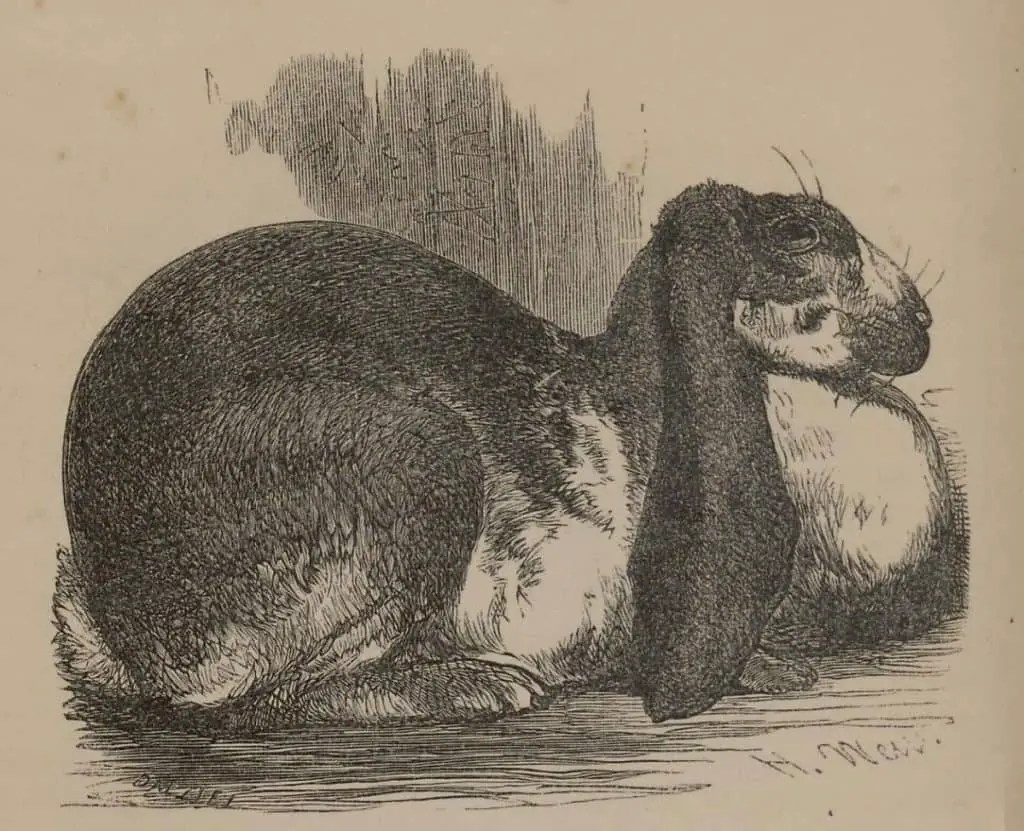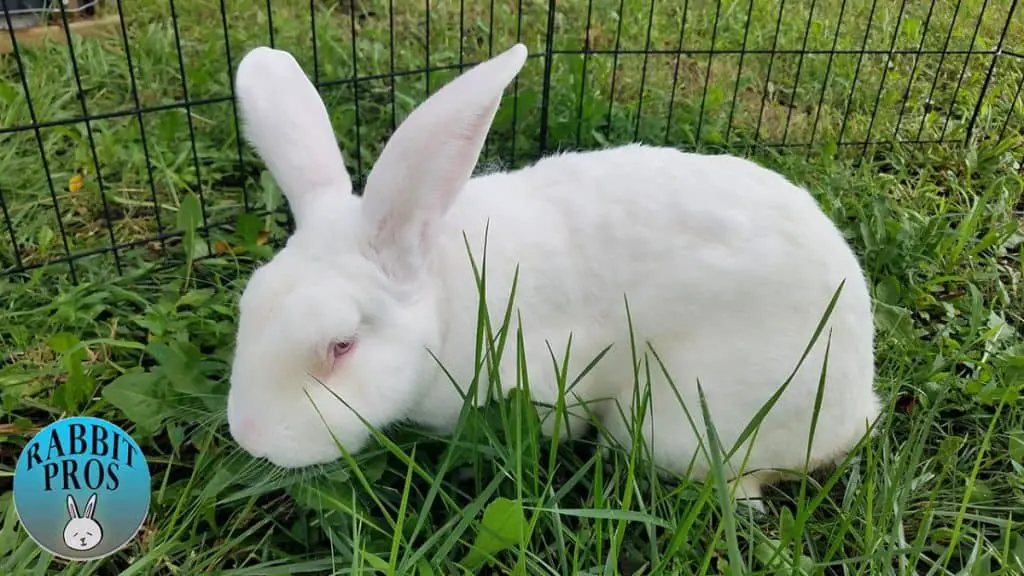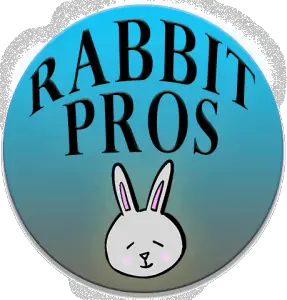Disclosure: We may earn money or products from the companies mentioned in this post.
The world’s largest rabbit breed is the Flemish Giant Rabbit. While most Flemish Giant rabbits grow to be around 16 pounds, the current world record biggest rabbit is a Flemish Giant that weighs 49 pounds is and over 4 feet long.
We’ll talk more about the world’s largest bunny here in a bit, but first let dig a little deeper into the biggest bunny breed, the Flemish Giants.
The Flemish Giant Rabbit is part of the Giant Rabbit breed category of rabbits. These breeds are so massive that they are often mistaken for other animals (e.g dogs). To be considered a giant breed of rabbit adults must reach a weight of at least 5.5kg (12 pounds).
Flemish Giant Rabbits are known to be very docile despite their massive size. As a matter of fact, their generally accepted nickname is the “Gentle Giant” of the rabbit world.
They are also one of the oldest domesticated breeds of rabbits that exist. It is widely believed that this breed came about by cross-breeding Belgian rabbits with giant Argentinian rabbits during the 16th century.
While they were originally raised for their meat and fur, they hopped their way into the hearts of men and now are best known for being companionable pets. They are gentle and highly trainable.
Although domesticated, these rabbits still retain the characteristics of their wild cousins. They have large ears, excellent hearing, and clear eyesight.

According to breed standards published by the ARBA, Flemish Giant Rabbits come in different coat colors: black, blue, fawn, sandy, light gray, steel gray, and white. Their coats are known to be smooth and even ending in a nice but, not so little bunny rump. Males are expected to weigh at least 13lbs (5.9 KG) and females 14 lbs. (6.4 KG).
The World’s Biggest Rabbit
The “World’s Largest Rabbit” titleholder for the Guinness Book of Records is a Flemish Giant Rabbit called Darius. . Darius is measured to be 4 feet and 3 inches long (129 cm). and weighs 49 pounds! He is approximately as long as a human child. He has also been the titleholder since April 6, 2010.
Darius is owned by Annette Edwards of Stoulton Worcestershire England
However, in an unfortunate event, Darius was found to have been stolen from his field enclosure last April 10 – 11, 2021. West Mercia Police of West London is still looking for leads as to the whereabouts of Darius. Annette, Darius’s owner, has raised the reward for his return to £1,000.
All the fans of Darius are holding their breaths and hopeful for the return of this gentle giant.
List Of Other Giant Rabbit Breeds
Flemish Giant Rabbits might be considered as “The King of Rabbits” but they are not alone in the giant category. Other giant breeds might not be as massive, but they are equally lovable and fluffy. Here are some of the most lovable large rabbit breeds:

French Lop
The French Lop is a giant breed that originated in France by breeding Butterfly Rabbits with English Lops. This breed of rabbit is characterized by its distinct droopy “lop” ears that measure 5 to 8 inches long and hang down below their jaws.
The breed is originally developed for their meat but their ears proved to be too beautiful for eating thus, these rabbits are now kept and bred as human companions.
They bear a resemblance to their Flemish Giant cousins but French lops have shorter bodies and usually weigh approximately 15 lbs. (6.8 KG).
French Lops can have soft dense coats with medium hair that are uniform in color or have white patches on their heads, chest, and legs.
According to recent studies, rabbits with lop ears tend to have more aural (ear) and dental problems than rabbits with their ears held straight up. Thus, extra care for French Lops is needed to ensure that they live long and comfortable lives by our side. [1]

New Zealand White
Contrary to popular belief, New Zealand White rabbits did not come from New Zealand. The New Zealand White was bred in America by crossing Belgian Hares and Flemish Giants.
The breed also did not originally have the snow-white fur that they are famous for. This was incorporated later when a New Zealand Red doe gave birth to a litter with albino babies that have unique crimson eyes.
New Zealand Whites have short and soft fur that requires occasional grooming. The standard weight for New Zealand White is 10 to 12 lbs for males and 9 to 11 lbs for females.
They can also come in a variety of coat colors such as red, white, black, blue, and any color mixed with white. This breed of rabbits is known to be gentle and perfect for families and seniors because of their relatively healthy disposition and good temperament.
Continental Giant
The Continental Giant is a descendant of the Flemish Giants. They are also called the “German Giant” in Germany.
It’s hard to tell the Flemish Giants and the Continental Giants apart. But, the Continental Giant is smaller. They are measured to weigh from approximately 16 to 20 pounds and can grow up to 3 feet long.
They also have thick and dense guard hairs with a soft undercoat. Continental Giants are categorized further into 2 varieties: White Continentals and Colored Continentals. The latter can have a variety of colors from black, steel, yellow, and opal.
The Continental Giant is also not recognized by the American Rabbit Breeders Association (ARBA). Owners of the breed make use of the British guidelines set by the British Rabbit Council (BRC) when taking care of this breed.
Giant Chinchilla
The Christmas morning of 1921 was changed forever when the Giant Chinchilla rabbit made its debut. The first known Giant Chinchilla rabbit was bred by Edward H. Stahl of Missouri and was a doe called the “Million Dollar Princess”
The Giant Chinchilla came into being by cross-breeding Chinchillas with Flemish Giants. They are known to weigh between 9.92 lbs. (4.50 KG) up to 12.12 lbs. (5.50 KG).
They have uniformly dense fur with a silky texture. Their belly, underjaw, eye circle, inside of ears and tail underparts are pure white while it’s under color is a deep blue slate. [2]
Giant Papillon
It’s hard not to recognize this breed with its broad ears that are held firmly upright. The Giant Papillon can weigh from 11 lbs. (5 KG) to 13 lbs. (13 KG). This breed also has a lighter bone structure compared to the other Giant breeds.
They have a dense, glossy coat with a pure white base color with colored patterns marking their eyes, eye circles, and cheeks. These markings can range a variety of colors such as blue, chocolate gray, black, tortoise and can sometimes even be tri-colored.
They also have a saddle strip that runs from the spine starting from their ears to their tails. Their side marking is rounded spots usually numbering from 6 to 8 that can be found on their flanks and thighs. [3]
The Giant Papillon is known to be active, curious, and gentle and is perfect for families with children.
Are Male Or Female Rabbits Generally Larger?
Generally, Female rabbits are bigger and heavier than their male counterparts. As an example, Male Flemish Giant rabbits have broader heads than their female counterparts and can take up to 1.5 years to reach full maturity.
Females have a Dewlap. A Dewlap is a fold of skin under their chins that is used to warm their young. Although this is common in females some male rabbits can also have smaller dewlaps.
Aside from their sizes female rabbits also differ from male rabbits in their behavior. Female rabbits are known to be more territorial than male rabbits. Male rabbits are more easy-going and calmer. Female rabbits also tend to dig holes and are very protective of other females.
Knowing the differences between Female and Male rabbits is important for their responsible ownership.
__________________
Our companion animals come in different shapes and sizes. They have different personalities and quirks that can be unique to each individual. The Giant Breed of Rabbits is no different. They are gentle giants that make perfect family members. The bigger they are, the more of them to love.
Do you own any of these large Rabbit Breeds? Do you have tips and tricks for those thinking about owning/already owning one? Don’t be shy to connect! Leave a comment below or jump over to our group on Facebook to meet fellow rabbit lovers.
~Stacey
Sources:
1C. Johnson & Burn, Charlotte. (2019). Lop-eared rabbits have more aural and dental problems than erect-eared rabbits: a rescue population study. Veterinary Record doi. 10.1136/vr.105163.
2Neirurerová, Petra & Fik, Martin & Andreji, Jaroslav & Mamojková, Eva. (2019). Analysis of coat quality of Chinchilla rabbit breed. Acta fytotechnica et zootechnica. 22. 17-20. 10.15414/afz.2019.22.01.17-20.
3Zigo, Frantisek & Pyskatý, Ondřej & Ondrašovičová, Silvia & Zigová, Martina & Šimek, Vlastimil & Supuka, Peter. (2020). Comparison of exterior traits in selected giant and medium rabbit breeds. World Rabbit Science. 28. 251. 10.4995/wrs.2020.12937.
